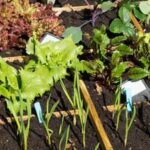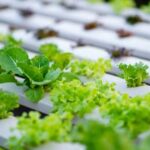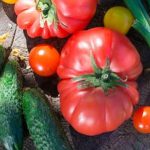City vegetable gardens have become a growing trend in urban areas, as more people seek to cultivate their own produce in the midst of city living. Urban agriculture has gained popularity due to its numerous benefits, including access to fresh, organic produce, reduced carbon footprint, and a deeper connection to nature. In this article, we will explore the concept of city vegetable gardens and provide valuable insights for anyone interested in starting their own urban garden.
As the demand for locally grown food continues to rise, city dwellers are increasingly turning to vegetable gardening as a sustainable and rewarding activity. Not only does it offer the satisfaction of growing one’s own food, but it also contributes to a healthier lifestyle and promotes environmental conservation. With the right knowledge and resources, individuals can transform even small urban spaces into thriving vegetable gardens that yield an abundance of nutritious produce.
In the following sections, we will delve into various aspects of city vegetable gardening, including choosing the right location, container gardening for limited spaces, vertical gardening options, essential tools and supplies needed for maintenance, selecting the best vegetables based on climate and space considerations, troubleshooting common issues faced by urban gardeners, and exploring community garden opportunities within the city.
Whether you are new to gardening or an experienced enthusiast looking to make the most of limited urban space, this article aims to provide practical guidance for establishing and maintaining a successful city vegetable garden.
Choosing the Right Location
When it comes to city vegetable gardens, choosing the right location is essential for ensuring successful growth and yields. One of the most important factors to consider when selecting a location for a city garden is sunlight.
Vegetables typically require at least 6-8 hours of direct sunlight per day to thrive, so it’s crucial to find a spot that receives adequate sun exposure. In urban environments, this can be challenging due to tall buildings and limited open spaces, but seeking out rooftops, balcony areas, or community garden plots that receive ample sunlight can make a significant difference in the success of your vegetable garden.
In addition to sunlight, soil quality is another critical consideration when choosing a location for a city vegetable garden. Urban soil may be contaminated with pollutants or lack necessary nutrients for plant growth. As such, utilizing raised beds or container gardening with high-quality soil can help mitigate these issues and provide a healthier growing environment for your vegetables. There are also options for testing and improving urban soil if you choose to plant directly in the ground.
Space considerations are also important when selecting a location for a city vegetable garden. Many urban dwellers have limited outdoor space, so maximizing the use of available area is key.
Vertical gardening and container gardening are effective solutions for making the most of small spaces, which will be discussed in more detail later in this article. By carefully considering sunlight exposure, soil quality, and space limitations when choosing the right location for your city vegetable garden, you can set yourself up for a successful and bountiful harvest despite the challenges of urban living.
Container Gardening
With the increasing popularity of city vegetable gardens, container gardening has become a go-to option for urban dwellers who have limited outdoor space. Container gardening offers the flexibility to grow a variety of vegetables, herbs, and fruits in a compact and manageable way. Choosing the right pots or containers is crucial for successful container gardening in the city.
When selecting pots for container gardening in the city, it’s essential to consider the material, size, and drainage capabilities. Terra cotta and plastic pots are popular choices due to their durability and affordability. Ensure that the containers have proper drainage holes to prevent waterlogging, which can lead to root rot. Additionally, larger containers provide more room for root growth and moisture retention, reducing the need for frequent watering.
In terms of the best vegetables to grow in containers in city vegetable gardens, many options thrive in confined spaces. Tomatoes, peppers, lettuce, spinach, radishes, and green onions are excellent choices for container gardening. These vegetables do well in smaller pots and require minimal maintenance. When planning a container garden in the city, consider the available space on balconies, patios, or windowsills to determine which vegetables will suit your setup best.
| Container Gardening Tips | Best Vegetables to Grow |
|---|---|
| Choose pots with good drainage | Tomatoes |
| Select larger containers for better root growth | Peppers |
| Consider location and available space for placement | Lettuce |
Vertical Gardening
Vertical gardening is an excellent option for city dwellers with limited space, providing the opportunity to grow fresh produce in a small footprint. By utilizing vertical space, such as walls, fences, or trellises, urban gardeners can maximize their growing area and harvest a bountiful crop of vegetables.
When creating a vertical vegetable garden, it’s essential to choose the right structure and consider factors such as sunlight exposure and support for climbing plants. Popular options for vertical gardens include hanging planters, wall-mounted containers, and tiered shelving units. These structures not only save space but also add aesthetic appeal to urban outdoor areas.
One key aspect of successful vertical gardening is selecting the right vegetables to grow. Certain crops are well-suited for vertical growing due to their compact nature or ability to climb and trail. Vegetables like tomatoes, cucumbers, peppers, and pole beans thrive in vertical environments, making them ideal choices for city vegetable gardens.
In addition to choosing the right structure and vegetables, proper maintenance is crucial for the success of a vertical garden. Regular watering and fertilization are essential, as well as keeping an eye out for pests and diseases that may affect vertically grown plants. With careful planning and attention to detail, city dwellers can enjoy a thriving vertical vegetable garden that provides a plentiful harvest despite limited space.
| Vegetables | Vertical Structure |
|---|---|
| Tomatoes | Hanging planters |
| Cucumbers | Wall-mounted containers |
| Peppers | Tiered shelving units |
Essential Tools and Supplies
Starting a city vegetable garden can be a rewarding and fulfilling experience, but it’s important to have the right tools and supplies to ensure success. Whether you’re working with limited space or have a larger area to cultivate, having the essential items on hand will make the process easier and more enjoyable. Here is a comprehensive list of tools and supplies needed for starting a city vegetable garden:
- High-quality soil: Good soil is the foundation of any successful garden. Look for nutrient-rich, well-draining soil that is suitable for growing vegetables.
- Fertilizer: Supplement your soil with organic fertilizers to provide essential nutrients for your plants’ growth and productivity.
- Watering equipment: Depending on the size of your garden, consider investing in a watering can, hose, or drip irrigation system to ensure your plants get the moisture they need.
- Gardening gloves and hand trowels: Protect your hands while working in the garden with sturdy gloves, and use hand trowels for planting and transplanting small vegetables.
- Pruning shears: Keep your plants healthy and tidy by pruning away dead or overgrown foliage with a good pair of pruning shears.
- Seeds or seedlings: Choose your favorite vegetables to grow from seeds or purchase young seedlings from a local nursery to kickstart your garden.
By having these tools and supplies ready, you can set yourself up for success when starting your own city vegetable garden. With the right resources at your disposal, you’ll be well-equipped to tackle any challenges that may arise as you cultivate fresh produce in an urban environment.
Remember that proper care for your city vegetable garden will also include regular maintenance tasks like watering, feeding, weeding, and protecting from pests. With dedication and the right tools, you’ll soon be enjoying a bountiful harvest of homegrown vegetables right in the heart of the city.
Selecting the Best Vegetables
When starting a city vegetable garden, it’s essential to carefully select the vegetables that will thrive in your specific climate, space, and the current season. By choosing the right vegetables, you can ensure a successful and bountiful harvest even in an urban environment. Here are some key factors to consider when selecting the best vegetables for your city garden:
Climate Considerations
Before deciding which vegetables to plant, it’s important to understand your city’s climate and growing zone. Some vegetables thrive in warmer temperatures, while others prefer cooler conditions. Research the average temperature range and frost dates for your area to determine which vegetables will do best in your city vegetable garden.
Space Constraints
In a city setting, space is often limited, so it’s crucial to choose vegetables that are well-suited for container or vertical gardening. Compact varieties of tomatoes, peppers, lettuce, and herbs are great options for small spaces. Additionally, consider using trellises or stakes for vining plants like cucumbers and peas to maximize vertical space.
Seasonality
City vegetable gardens should be planned according to the changing seasons. Choose vegetables that are suitable for the current season and can withstand any temperature fluctuations typical of urban environments. Cool-season crops like spinach and kale are ideal for early spring or fall planting, while heat-loving crops such as tomatoes and peppers thrive in the summer months.
By considering these factors when selecting vegetables for your city garden, you can ensure a successful and productive harvest. Additionally, experimenting with different varieties and keeping track of what works best in your specific urban environment will help you refine your gardening skills over time. With thoughtful planning and careful selection of vegetables, even city dwellers can enjoy the rewards of growing their own fresh produce right at home.
Maintaining and Troubleshooting
City vegetable gardens can be a rewarding endeavor, but they also come with their fair share of challenges. From dealing with pests to ensuring proper watering and preventing disease, maintaining a successful urban garden requires careful attention and troubleshooting skills. Here are some common challenges faced by city vegetable gardeners and how to address them:
1. Pests: In a city environment, pests can be particularly problematic for vegetable gardens. Common critters such as aphids, slugs, and caterpillars can wreak havoc on your crops if left unchecked. To combat these pests, consider using natural remedies like insecticidal soaps or neem oil. You can also encourage beneficial insects like ladybugs and lacewings to help control pest populations.
2. Watering Issues: Proper watering is crucial for the success of any garden, but it can be especially challenging in the city where water sources may be limited. Implementing a drip irrigation system or using self-watering containers can help ensure that your plants receive adequate moisture without wastage. Additionally, mulching around your plants can help retain soil moisture and reduce the frequency of watering.
3. Disease Prevention: Urban environments can create favorable conditions for the spread of plant diseases, making disease prevention a key concern for city vegetable gardeners. To prevent diseases such as powdery mildew or fungal infections, practice good sanitation by removing infected plant material and maintaining proper air circulation around your plants. Using disease-resistant varieties and rotating crops can also help minimize the risk of disease in your city garden.
By being proactive in addressing these common challenges, city vegetable gardeners can maintain thriving urban gardens that yield bountiful harvests of fresh, homegrown produce. With careful attention to pests, watering techniques, and disease prevention strategies, you can overcome the obstacles often associated with urban agriculture and enjoy a successful vegetable garden in the heart of the city.
Community Gardens and Resources
In conclusion, city vegetable gardens offer an array of benefits to urban dwellers, including access to fresh produce, enhanced green spaces, and a sense of connection to nature. As the trend of urban agriculture continues to grow, more individuals are seeking opportunities to cultivate their own crops within city limits. Whether through container gardening on balconies, vertical gardening on walls, or participating in community garden initiatives, city residents have an array of options for engaging in urban agriculture.
One key aspect of city vegetable gardening is the opportunity to participate in community gardens. These shared spaces not only provide individuals with access to larger plots of land for cultivation but also create a sense of community and collaboration among participants. By joining or creating a community garden, urban gardeners can share knowledge, resources, and experiences while contributing to the overall greening and food production within the city.
Furthermore, urban gardeners can benefit from various resources designed to support their efforts. From local gardening clubs and cooperatives to online forums and educational workshops, there are numerous avenues for obtaining guidance and assistance in establishing and maintaining city vegetable gardens. As interest in sustainable living and food security continues to gain traction, the availability of these resources can empower urban residents to take an active role in cultivating their own fresh produce while contributing positively to their communities.
Frequently Asked Questions
What Vegetables Are Good for Urban Gardens?
When it comes to urban gardens, there are many vegetables that thrive in small spaces. Leafy greens like spinach, lettuce, and kale are great options, as well as compact plants like tomatoes, peppers, and herbs. These vegetables can be easily grown in containers or raised beds on a balcony or patio.
How Do You Make an Urban Vegetable Garden?
To create an urban vegetable garden, start by choosing the right location with adequate sunlight and access to water. Next, prepare the soil by adding compost and organic matter. Then, select the vegetables you want to grow and plant them in appropriate containers or raised beds. Regular watering and maintenance are crucial for a successful urban vegetable garden.
How Do You Grow a City Garden?
Growing a city garden requires careful planning and consideration of space limitations. Start by assessing the available space for gardening – whether it’s a rooftop, balcony, or small backyard. Choose compact vegetable varieties that can thrive in containers or raised beds.
Utilize vertical space with trellises or hanging planters to maximize growing area. Regular maintenance and care will help ensure a healthy city garden yield.

If you’re looking to get into vegetable gardening, or are just looking for some tips on how to make your current garden better, then you’ve come to the right place! My name is Ethel and I have been gardening for years. In this blog, I’m going to share with you some of my best tips on how to create a successful vegetable garden.





